Michigan is an important industrial, agricultural, tourist, and mining state in the Great Lakes region of the United States. Lansing is its capital, and Detroit is its largest city.
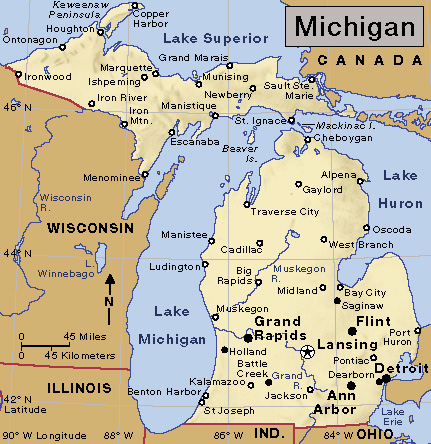

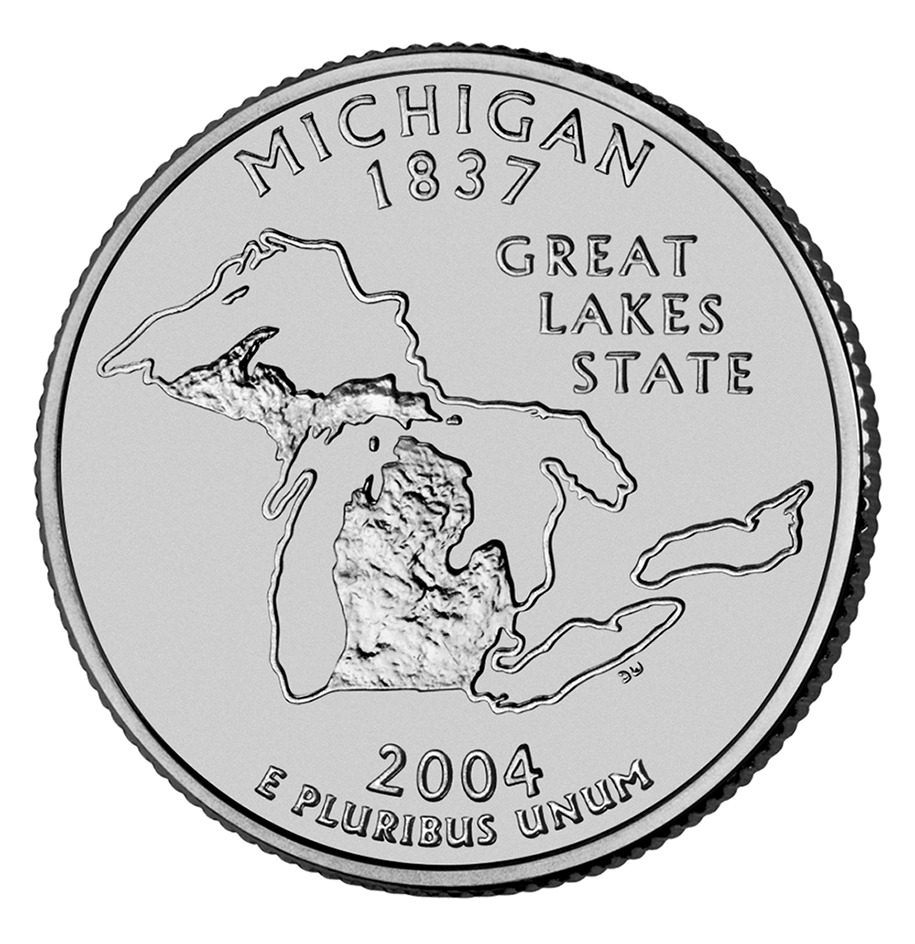
Michigan touches four of the five Great Lakes—Erie, Huron, Michigan, and Superior. The state’s 3,288-mile (5,292-kilometer) shoreline is longer than that of any other state except Alaska. Michigan consists of two separate land areas, called the Upper Peninsula and the Lower Peninsula. The two peninsulas are connected by the Mackinac Bridge, which spans 5 miles (8 kilometers) across the Straits of Mackinac.
Michigan is one of the nation’s leading manufacturing states. The Detroit area produces more cars and trucks than any other part of the nation. Detroit is called the Automobile Capital of the World and the Motor City. Automobiles are also made in other cities in Michigan. Chemicals, food products, machinery, and metal products are also manufactured in Michigan.
Most agricultural activity in Michigan takes place in the southern half of the Lower Peninsula. Extensive areas of the Lower Peninsula near the shore of Lake Michigan are excellent for fruit growing. Michigan is among the leading states in growing apples, cherries, grapes, and other fruits.
Michigan’s scenic beauty and its resort and recreation facilities attract many visitors. In addition to the Great Lakes, Michigan has thousands of smaller lakes. Forests cover over half the state. Michigan offers excellent hunting and fishing opportunities for sport enthusiasts.
Michigan is second only to Minnesota in iron ore production. Iron ore is mined in the Upper Peninsula. Natural gas and petroleum are found throughout the Lower Peninsula. Michigan is also an important producer of portland cement and sand and gravel.
Service industries, such as health care and retail trade, employ many people. Service industries are concentrated in the metropolitan areas.
French explorers of the early 1600’s were the first Europeans to visit what is now Michigan. France controlled the region for nearly 150 years but did little to develop it. Britain gained control after defeating France in the French and Indian Wars (1689-1763). In 1787, the area became part of the Northwest Territory of the United States. In 1805, Congress established the Territory of Michigan. In 1837, Michigan became the 26th state.
The name Michigan comes from the Ojibwe word Michigama, which means great, or large, lake. The state’s nickname, Wolverine State, may stem from an 1835 land dispute between Michigan and Ohio. Some people believe that, at that time, Ohioans called Michigan settlers wolverines because they felt that the settlers were going after the land as aggressively as a wolverine goes after its prey. The state is also known as the Water Wonderland, because of its many beautiful lakes and streams. Including its share of the Great Lakes, Michigan has more fresh water than any other state. The Upper Peninsula is sometimes called the Land of Hiawatha because it is described in The Song of Hiawatha (1855), a poem by the American poet Henry Wadsworth Longfellow.
People
Population.
The 2020 United States census reported that Michigan had 10,077,331 people. The population had increased about 2 percent over the 2010 figure of 9,883,640. According to the 2020 census, Michigan ranks 10th in population among the 50 states.
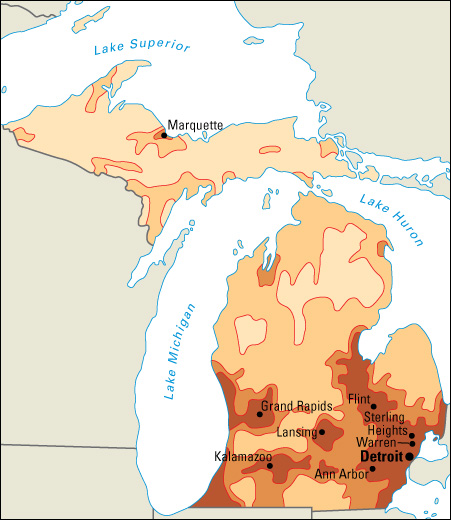
About 85 percent of the people of Michigan make their homes in one of the state’s 16 metropolitan areas (see Metropolitan area). These are Ann Arbor, Battle Creek, Bay City, Detroit-Warren-Dearborn, Flint, Grand Rapids-Wyoming-Kentwood, Jackson, Kalamazoo-Portage, Lansing-East Lansing, Midland, Monroe, Muskegon, Niles, Saginaw, South Bend (Indiana)-Mishawaka (Indiana), and Traverse City.
Detroit is Michigan’s largest city and one of the largest cities in the United States. Other large cities in Michigan, in order of population, are Grand Rapids, Warren, Sterling Heights, Ann Arbor, Lansing, Dearborn, Livonia, Troy, Westland, Farmington Hills, and Flint. All of these cities have populations of more than 80,000, and all of them are in the Lower Peninsula. The largest city in the Upper Peninsula is Marquette. It has a population of about 21,000. 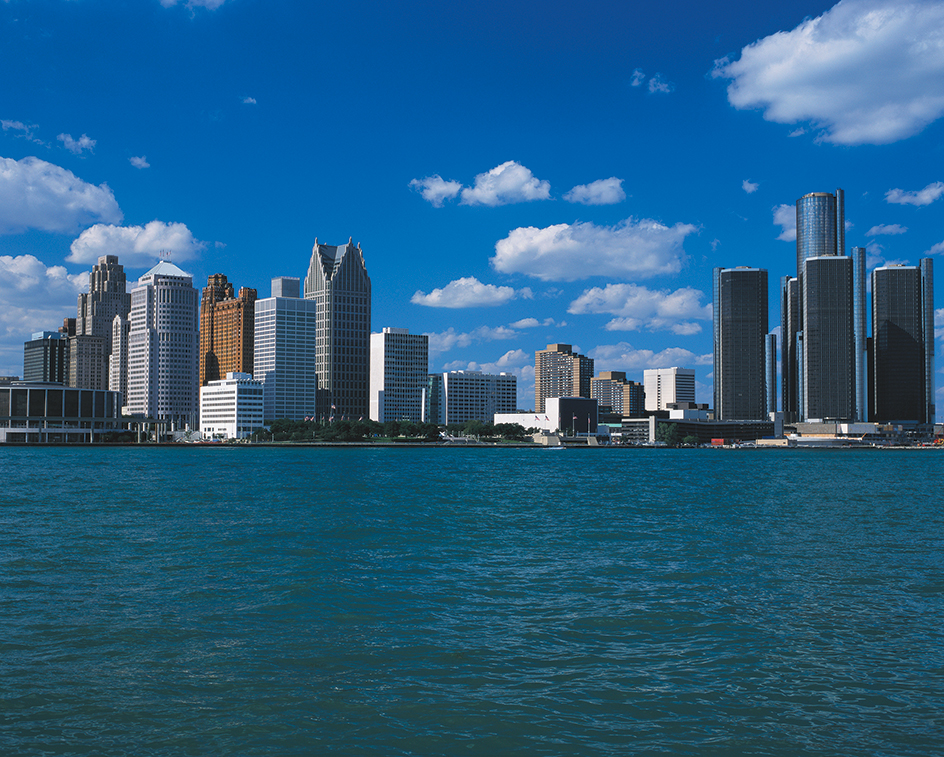
The Lower Peninsula has a population density of about 240 people per square mile (92 per square kilometer). Figures for the Upper Peninsula are much lower—about 20 per square mile (8 per square kilometer). Overall, Michigan has a population density of about 170 people per square mile (66 per square kilometer).
About 92 out of 100 people in Michigan were born in the United States. About 15 percent of Michigan’s people are African Americans. Hispanics account for about 6 percent of the state’s population, and Asians for about 3 percent. Other large groups include people of Arab, Dutch, English, French, German, Irish, Italian, and Polish descent.
Schools.
Roman Catholic missionaries who came to the region in the 1600’s taught among the Indigenous (native) people. In 1798, Father Gabriel Richard came to Detroit to serve as pastor of Ste. Anne’s Roman Catholic Church. He established schools to provide regular classes and vocational training for Indigenous and white children.
In 1827, the territorial legislature passed a law calling for the establishment of community schools maintained by townships. This law is considered the state’s first public school law. After Michigan entered the Union in 1837, the Legislature approved a statewide system of public education, including a university. The new state Constitution provided for the appointment of a superintendent of public instruction to administer the public school system. The Michigan superintendent of public instruction was the first such administrator in the United States.
Eastern Michigan University, established in 1849, was the first state teachers college west of New York. Michigan State University, founded in 1855 as Michigan Agricultural College, was the first institution of higher education to teach scientific agriculture. In 1879, the University of Michigan became one of the first state universities to establish a chair (special teaching position) in education.
The State Board of Education directs Michigan’s public schools. Eight voting members of the board are elected. There are also two nonvoting members. The board appoints the superintendent of public instruction, who administers the Department of Education. Children must attend school from age 6 to 18. For the number of students and teachers in Michigan, see Education (table: U.S. students, teachers, and school expenditures).
Libraries.
The Library of Michigan—the state library—was founded in Detroit in 1828, when many settlers were moving into the Territory of Michigan. Today, the library has one of the largest genealogy collections in the nation. It also has materials related to Michigan and the Great Lakes, collections of state and federal documents, and collections dealing with law. Michigan also has cooperative library organizations that share resources and services among libraries.
The William L. Clements Library at the University of Michigan has a famous collection on early America. The Gerald R. Ford Presidential Library in Ann Arbor contains the papers of the 38th U.S. president. The Detroit Public Library has the Burton Historical Collection. This collection contains reference works on Michigan and the Great Lakes area. The Walter P. Reuther Library of Wayne State University in Detroit has material related to the history of labor, Michigan, and the Detroit area.
Museums.
The Detroit Institute of Arts, founded in 1885, includes murals by the famous Mexican artist Diego Rivera. The Detroit Historical Museum contains exhibits on the history of southeastern Michigan. The Charles H. Wright Museum of African American History in Detroit has displays related to the history of Black people in the United States. Greenfield Village, in Dearborn, is a collection of famous historic buildings dating from the late 1600’s to the early 1900’s. Assembled and restored by the automobile manufacturer Henry Ford, these structures are related to the history of American invention and industry (see Greenfield Village). 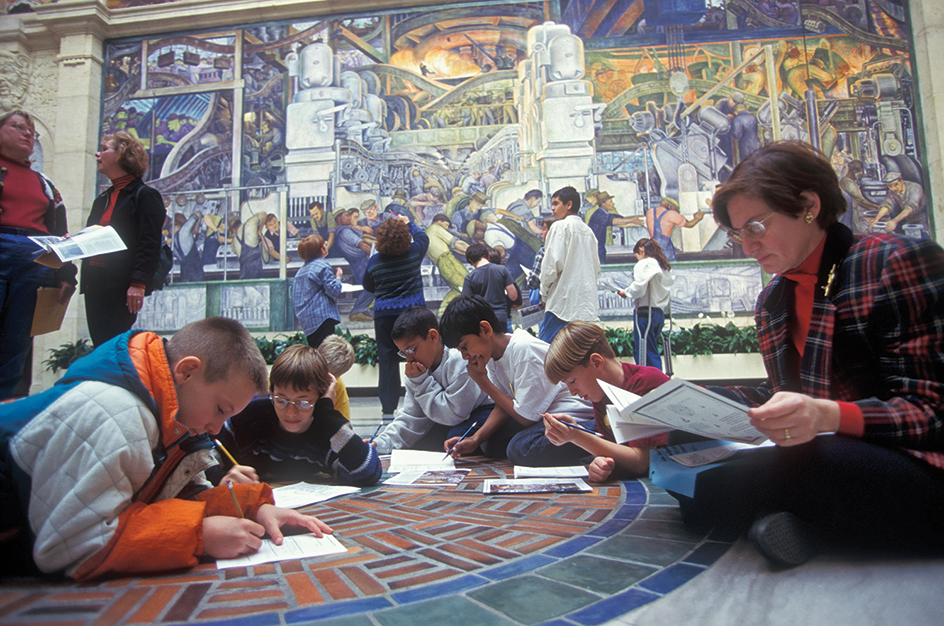
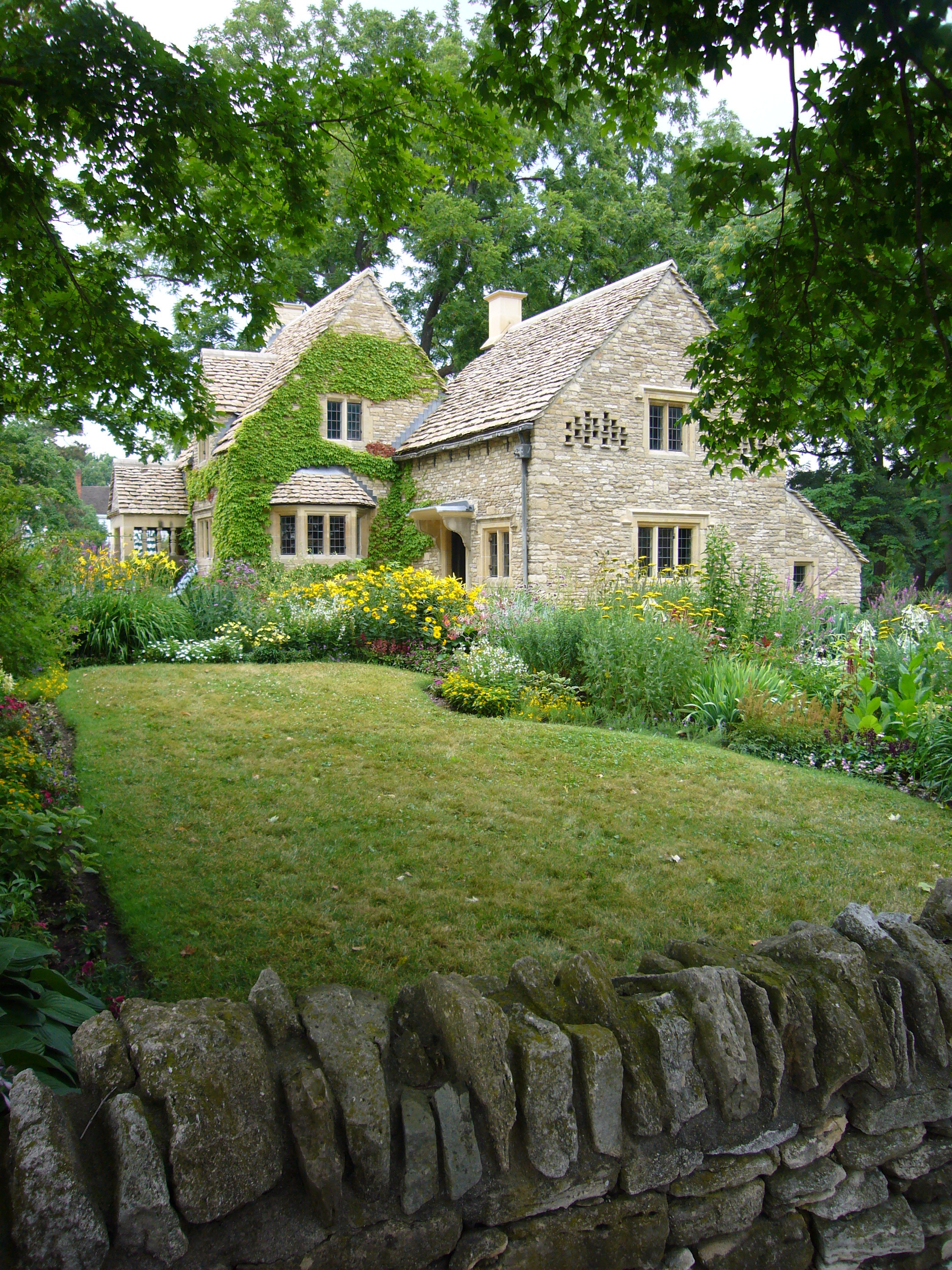
The Michigan History Museum in Lansing tells the story of Michigan’s past from prehistoric to modern times. The Grand Rapids Public Museum has exhibits on the natural and cultural history of west Michigan. The Gerald R. Ford Presidential Museum in Grand Rapids contains exhibits on the former U.S. president. The Michigan Science Center includes interactive exhibits on science and technology, an IMAX theater, and a planetarium. The Sloan Museum of Discovery in Flint focuses on regional history, science, and historical automobiles. The Dr. Beaumont Museum on Mackinac Island features the instruments of William Beaumont, a surgeon who made discoveries about digestion (see Beaumont, William).
Visitor’s guide
Michigan has year-round activities for people who enjoy sports and the outdoors. Thousands of lakes, along with many rivers and streams, attract swimmers, water skiers, fishing enthusiasts, and boaters. Thick forests and scenic woodlands appeal to hunters and campers. In winter, many people travel to Michigan for skiing, skating, snowmobiling, tobogganing, iceboat racing, and ice fishing. One of the world’s largest artificially created ski-flying hills is in Ironwood at Copper Peak. Sightseers are drawn to the many beautiful waterfalls as well as to dunes and the rugged “Copper Country” of the western Upper Peninsula. Popular ski areas in the state also include Crystal Mountain on the Lower Peninsula.
One of Michigan’s most popular annual events is the weeklong Tulip Time Festival, held each May in Holland. The people of the city dress in traditional Dutch costumes. The festival includes parades, dancing in wooden shoes, and ceremonial street washing.
Land and climate
Land regions.
Michigan has two main land regions: (1) the Northern Highland and (2) the Great Lakes Plains.
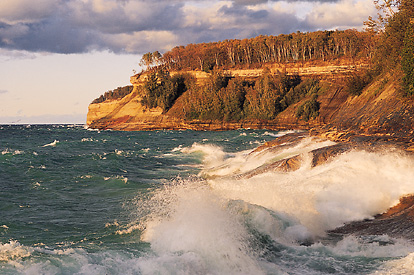
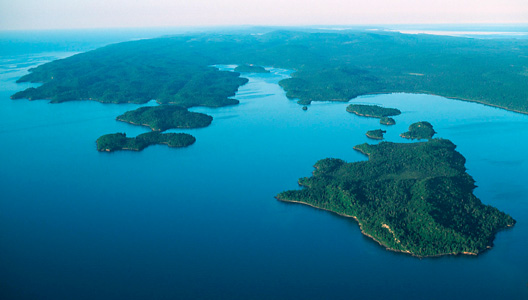
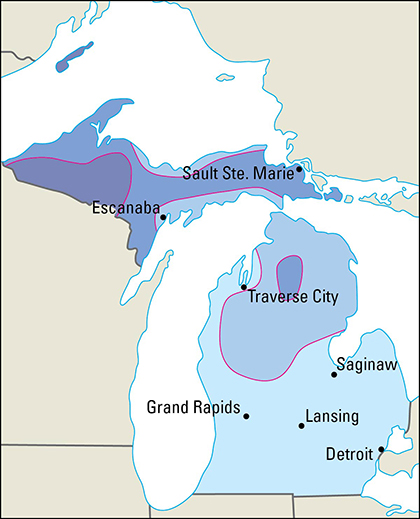
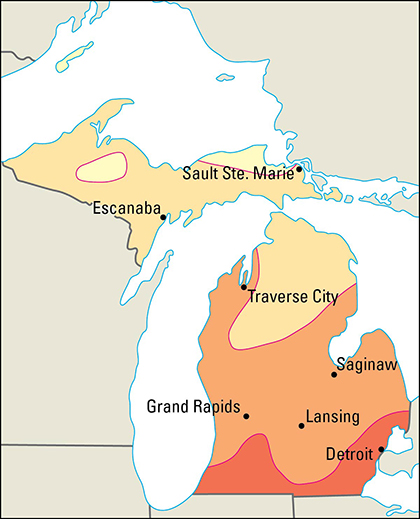
The Northern Highland
extends along Lake Superior and covers the western half of the Upper Peninsula. Much of the region is rugged, rising from about 600 to 1,979 feet (180 to 603 meters) above sea level. Michigan’s highest hills and waterfalls are in this region. The Porcupine Mountains in extreme northwestern Michigan rise more than 1,000 feet (305 meters) from the shores of Lake Superior. Mount Arvon is the highest point in the state, 1,979 feet (603 meters) above sea level. Forests cover most of these hills. Hard bedrock is close to the surface over much of this region. The Northern Highland has some of the nation’s richest iron and copper deposits.
The Great Lakes Plains
stretch along the Great Lakes from Wisconsin to Ohio. They are part of a large Midwestern land region called the Interior Plains. In Michigan, the Great Lakes Plains cover the eastern Upper Peninsula and the entire Lower Peninsula. In the Upper Peninsula, large parts of the area are lowlands covered by swamps. A short growing season and poor soils make many parts of the area unsuitable for farming
Much of the Lower Peninsula was scraped fairly level by the action of glaciers, but some parts are rolling and hilly. Parts of the north-central Lower Peninsula rise 1,200 to 1,400 feet (366 to 427 meters) above sea level. Many high bluffs and sand dunes border Lake Michigan. The state’s lowest point, 571 feet (174 meters) above sea level, is along the shore of Lake Erie. Parts of the northern Lower Peninsula have sandy wastes, covered with jack pine trees, scrub, and stumps. The southern half has extensive areas of good farmland.
Shoreline
of Michigan is 3,288 miles (5,292 kilometers) long—more than that of any other state except Alaska. This includes 1,056 miles (1,699 kilometers) of island shoreline. Four Great Lakes border the state—Erie, Huron, Michigan, and Superior. No part of Michigan lies more than 85 miles (137 kilometers) from one of these lakes.
Bays along the Lower Peninsula include Grand Traverse and Little Traverse on Lake Michigan, and Saginaw on Lake Huron. The Upper Peninsula has Whitefish and Keweenaw bays on Lake Superior, and Big Bay de Noc on Lake Michigan.
Islands.
Michigan’s largest island, Isle Royale, covers about 210 square miles (544 square kilometers) in Lake Superior (see Isle Royale National Park). The Beaver and Manitou islands are in Lake Michigan. Bois Blanc, Mackinac, and Round islands are in Lake Huron, just east of the Straits of Mackinac. Drummond Island, also in Lake Huron, lies off the eastern tip of the Upper Peninsula. The small islands in the Detroit River include Belle Isle and Grosse Ile.
Rivers, waterfalls, and lakes.
The chief rivers of the Upper Peninsula include the Escanaba, Manistique, Menominee, Ontonagon, Sturgeon, Tahquamenon, and Whitefish. Principal rivers in the Lower Peninsula are the Au Sable, Clinton, Grand, Huron, Kalamazoo, Manistee, Muskegon, Raisin, Saginaw, and St. Joseph. The Grand River, 260 miles (418 kilometers) long, is the longest in the state. The Detroit, St. Clair, and St. Marys rivers are important for commerce. The Detroit River connects Lakes Erie and St. Clair. The St. Clair River joins Lakes Huron and St. Clair. The St. Marys River is the connecting channel between Lakes Superior and Huron (see Saint Marys River).
Michigan’s Upper Peninsula has about 150 beautiful waterfalls. The best-known falls are the Upper and Lower Tahquamenon Falls on the Tahquamenon River. Other well-known waterfalls in the Upper Peninsula include the Agate, Bond, Laughing Whitefish, Miners, and Munising. The best-known waterfall in the Lower Peninsula is Ocqueouc Falls, near Black Lake. 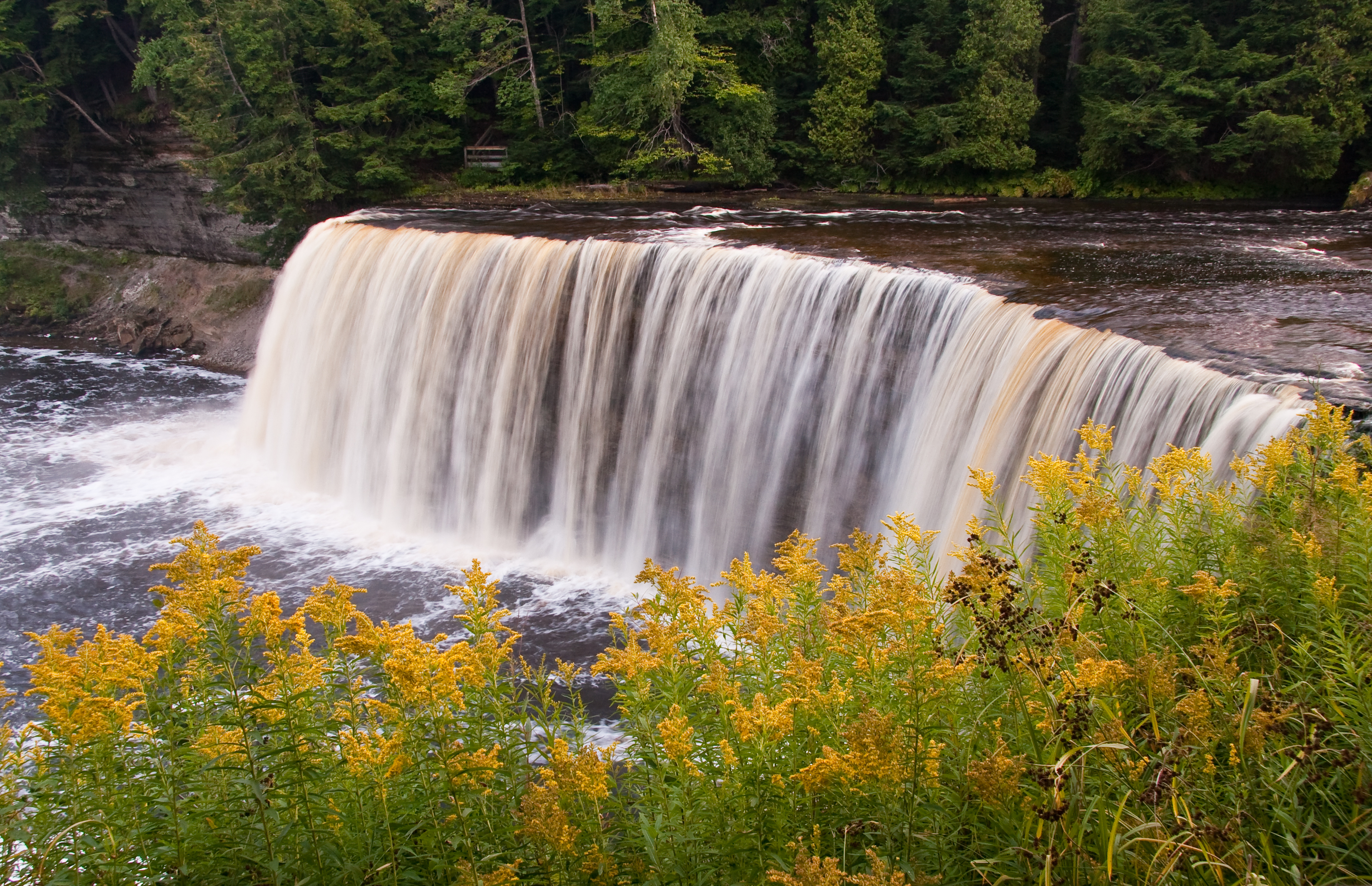
Michigan has more than 11,000 inland lakes. The largest is 31-square-mile (80-square-kilometer) Houghton Lake in the north-central Lower Peninsula. Most of the larger lakes are in the Lower Peninsula. They include Black, Burt, Charlevoix, Crystal, Higgins, Mullet, and Torch lakes. Lake Gogebic is the largest lake in the Upper Peninsula.
Plant and animal life.
Forests cover more than half of Michigan. Much of the state’s forest land is covered by such hardwood trees as aspens, beeches, birches, maples, and oaks. Softwoods cover most of the remaining forest land. These include cedars, firs, hemlocks, larches, pines, and spruces.
Bittersweet, clematis, grapes, moonseed, and several kinds of smilax grow wild in Michigan’s thickest forests. Such shrubs as blackberry, currant, elder, gooseberry, raspberry, rose, and viburnum thrive in the more open forest areas. Ferns and mosses grow in the swamps, as do cranberries and lady’s-slippers. Such flowers as the arbutus, mandrake, trillium, and violet bloom in late April to early May. Flowers that bloom later in the year include the daisy, iris, orange milkweed, rose, shooting star, and tiger lily. Other common flowers include the aster, chicory, goldenrod, and sunflower.
Michigan probably has more deer than any other state except Texas. Other common fur and game animals in Michigan include badgers, black bears, minks, muskrats, opossums, rabbits, raccoons, red foxes, skunks, squirrels, and weasels. Hundreds of kinds of birds live in the state. Game birds most prized by hunters include ducks, geese, grouse, and pheasants.
Fishes found in Michigan’s lakes, rivers, and streams include bass, crappie, perch, pike, salmon, trout, and walleye. Smelt runs occur each spring in streams that empty into parts of Lakes Huron and Michigan. Other fishes common in Michigan’s waters include alewives, catfish, and chubs. Carp, lake herring, and whitefish are common in the Great Lakes. But such invasive species as sea lamprey, spiny water flea, and zebra mussel threaten native aquatic life (see Invasive species).
Climate.
Michigan has a moist climate with cold winters and warm summers in the south and cool summers in the north. Winds off the Great Lakes bring much cloudiness. About 6 of every 10 days are partly cloudy in summer and about 7 of every 10 days in winter. Fall and winter are especially cloudy in the western Lower Peninsula and the eastern Upper Peninsula. 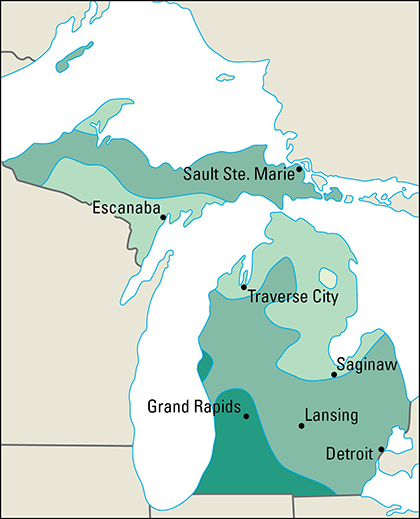
The Lower Peninsula is generally warmer than the Upper Peninsula. Average January temperatures range from 16 °F (–9 °C) in the Upper Peninsula to 25 °F (–4 °C) in the southern Lower Peninsula. July temperatures average 66 °F (19 °C) in the Upper Peninsula and 73 °F (23 °C) in the southern Lower Peninsula. Michigan’s record low temperature, –51 °F (–46 °C), occurred in Vanderbilt on Feb. 9, 1934. Mio recorded the state’s highest temperature, 112 °F (44 °C), on July 13, 1936. Air cooled by Lake Michigan in the spring usually delays the budding of fruit trees until the danger of frosts has passed.
Yearly precipitation ranges from approximately 26 to 36 inches (66 to 91 centimeters). Annual snowfall varies from about 40 inches (102 centimeters) in the southeastern Lower Peninsula to more than 150 inches (380 centimeters) in the western Upper Peninsula. The state’s record snowfall, 2761/2 inches (702.3 centimeters), occurred at Houghton during the winter of 1949-1950.
Economy
Michigan has a blend of new and traditional industries. But the state’s economy will be associated primarily with the automobile for a long time to come. Michigan ranks among the nation’s leading manufacturing states. The production of transportation equipment ranks as the state’s most important manufacturing industry. Detroit is Michigan’s chief manufacturing center.
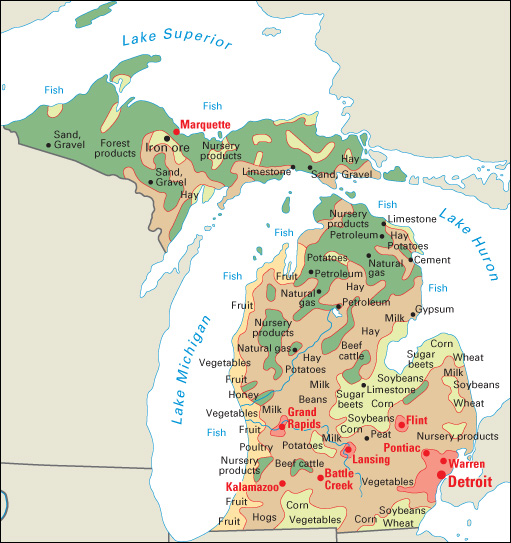
Service industries are increasingly important in the state. Included among these are high-technology companies that develop software and other products.
Important natural gas and petroleum deposits lie under Michigan’s Lower Peninsula. Large iron ore deposits are found in the Upper Peninsula. The southern Lower Peninsula has the best farmland. Most of the state’s livestock and crops are raised there. Fruit thrives along the Lake Michigan shoreline of the Lower Peninsula.
Michigan is a leading tourist state. Tens of millions of people visit the state annually. Natural attractions, and resort and recreation areas, can be found in many parts of the Upper and Lower peninsulas.
Natural resources
of Michigan include fertile soils, rich mineral deposits, widespread forests, plentiful water, and abundant plant and animal life.
Soil.
The Upper Peninsula of Michigan has soils that vary from fertile loams to areas of poor soils and infertile sands. The northern section of the Lower Peninsula mostly has sandy soils, which are often low in fertility. A variety of soils cover former glacial lakebeds next to Saginaw Bay and along the shoreline of eastern and southeastern Michigan. In other parts of the Lower Peninsula, soils range from rich, dark brown or black loams and gray sands, to infertile soils that are shallow and poorly drained. The state’s richest soils are in the southern half of the Lower Peninsula.
Minerals.
Michigan’s Upper Peninsula has vast iron ore and copper deposits. Great stores of iron ore lie in the Marquette Range of the central Upper Peninsula. The Menominee Range in the southern Upper Peninsula and the Gogebic Range in the western corner also have enormous iron ore deposits. These iron deposits are part of one of the greatest known iron ore regions in the world. The Keweenaw Peninsula, which forms the northernmost tip of the Upper Peninsula, is one of the few sources of native (pure) copper in the world.
The Lower Peninsula holds valuable deposits of petroleum and natural gas. The largest of these deposits lies in the northern part of the Lower Peninsula. The Lower Peninsula also has extensive deposits of salt. Brines containing calcium chloride and magnesium also occur in this region. Gypsum and limestone are mined throughout the state. Many counties in Michigan have deposits of sand and gravel.
Service industries,
taken together, account for the largest portion of both Michigan’s employment and its gross domestic product—the total value of all goods and services produced in the state in a year. Michigan’s service industries are concentrated in the metropolitan areas, especially the Detroit area.
Detroit is the state’s leading banking and insurance center. The federal government has many branch offices there. The port of Detroit handles much of Michigan’s international wholesale trade. Several railroad and trucking companies have large operations in Detroit.
Many hotels, restaurants, and retail trade establishments operate in the Detroit, Flint, Grand Rapids, and Lansing areas. Lansing, the state capital, is the center of government. Lansing is also the home of Jackson National Life Insurance Company, a large insurance company. Engineering and research companies in the state receive much business from the automobile industry. These industries help Michigan rank among the nation’s leaders in the size of its high-tech work force.
Manufacturing.
Michigan ranks as a leading manufacturing state. About half of Michigan’s manufactured goods are produced in the Detroit metropolitan area.
Transportation equipment is Michigan’s leading type of manufactured product by far. The transportation equipment industries employ over a fourth of all the manufacturing workers in the state.
Michigan is the leading manufacturer of automobiles in the nation. Detroit is called the Automobile Capital of the World, or Motor City. The world headquarters of Ford Motor Company and General Motors are in the Detroit area. Due to increased competition from other countries and other states of the United States, however, many auto plants in Michigan have closed or reduced production. Other vehicles produced in Michigan include full-sized and light trucks, vans and sport utility vehicles, boats, and buses. 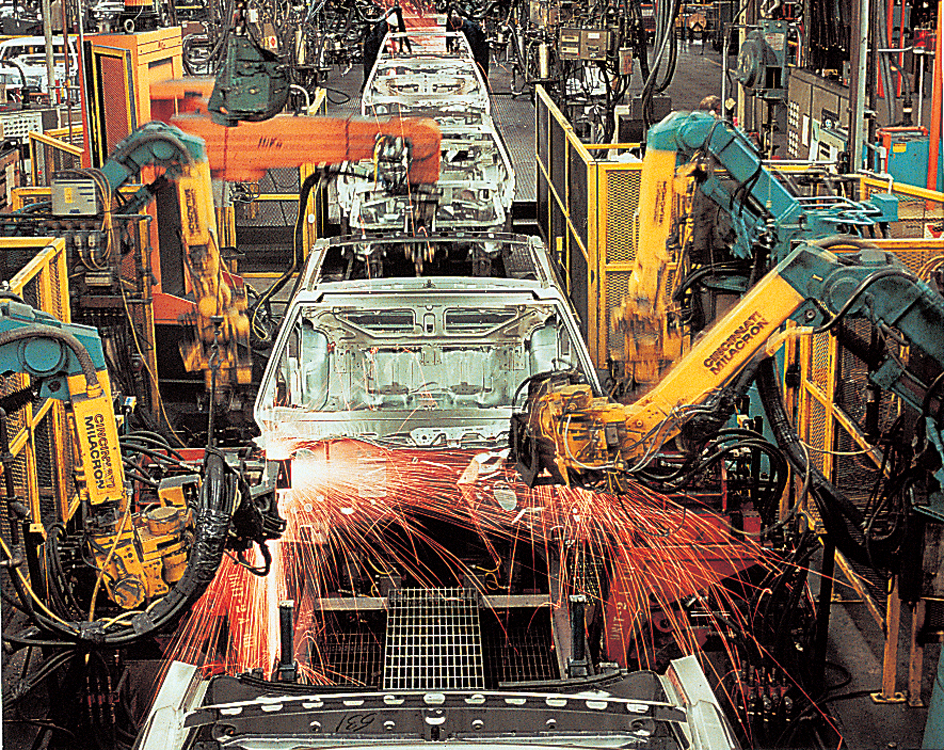
Fabricated metal products and machinery are valuable manufacturing activities. The Detroit area accounts for about half of the total production for both activities. Michigan’s fabricated metal products include hand tools, hardware, and machine shop products. Chisels, dies, and other machine parts are the leading machinery products. Other important kinds of machinery include conveyors, engines, heating and cooling equipment, and pumps.
Chemicals and food products are also important. Pharmaceuticals (medicinal drugs) are the leading type of chemical product. Pharmaceuticals are produced in the Detroit and Kalamazoo areas. Midland is home to the headquarters of the Dow Chemical Company, one of the world’s largest chemical manufacturers. Michigan is an important food-processing state. Battle Creek is often called The Cereal Bowl of America. The city is home to Kellogg, a leading U.S. maker of breakfast cereal. Fremont, home to the Gerber Products Company, is often called The Baby Food Capital of the World. Michigan also produces dairy products, fruit and vegetable products, and meat products.
Other manufactured products include home and office furniture, nonmetallic mineral products, plastics and rubber products, and primary metals. The Grand Rapids area manufactures much of the office furniture made in Michigan. The state’s leading nonmetallic mineral products are cement, concrete, and glass products. Factories throughout the state manufacture plastics and rubber products. Iron and steel are made in the Detroit area.
Agriculture.
Farmland covers about a fourth of Michigan’s land area. Michigan’s best farmland is in the southern part of the state. 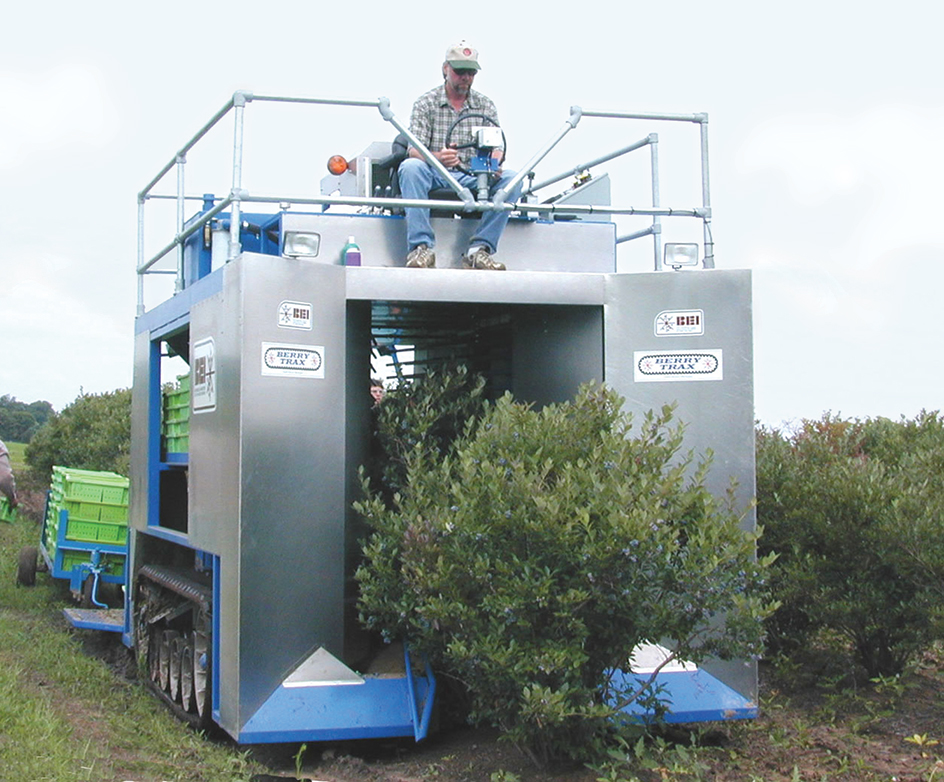
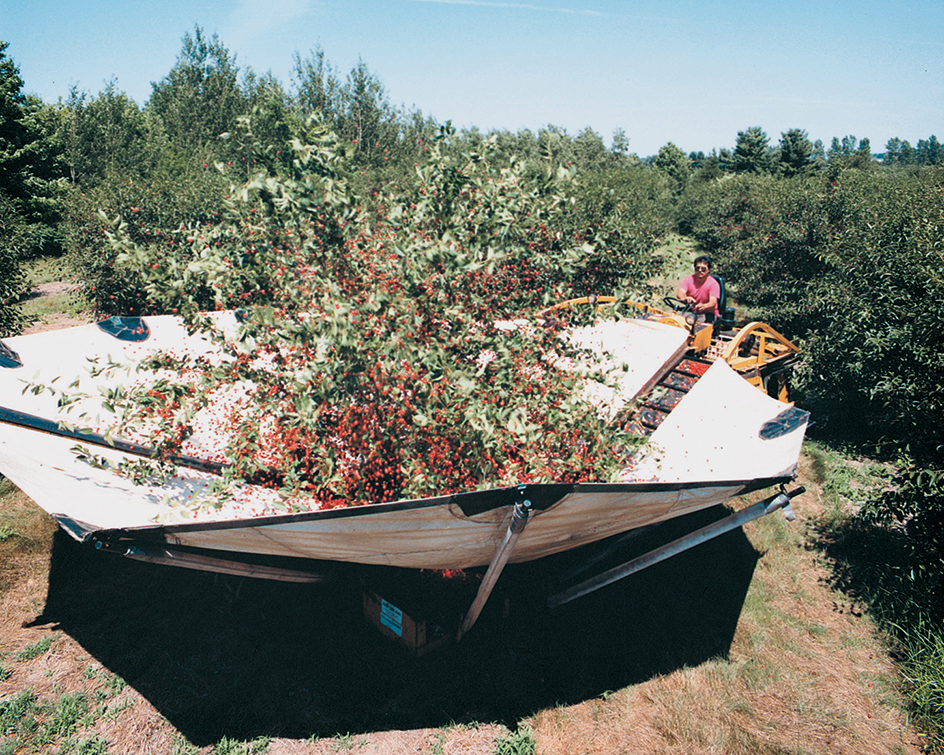
Crops provide over half of the total farm income. The state’s leading field crops include corn, dry edible beans, hay, soybeans, sugar beets, and wheat. Michigan is a leading producer of sugar beets and dry edible beans. The state leads the nation in the production of black beans, Roman beans (also known as cranberry beans), and small red beans. Plants grown in greenhouses and nurseries, such as flowers and shrubbery, are also an important source of income. Michigan is one of the nation’s largest growers of Christmas trees.
The land along Lake Michigan in the Lower Peninsula is one of the most productive fruit-growing belts in North America. Michigan ranks among the leading states in raising blueberries, cherries, and grapes. Fruit tree blossoms attract many bees in spring, making honey an important by-product of the fruit industry. Traverse City is famous for its cherries and wine.
Most of Michigan’s vegetable farming takes place in the southern half of the Lower Peninsula. Important vegetable crops raised in the state include asparagus, carrots, celery, cucumbers, potatoes, snap beans, squash, sweet corn, and tomatoes.
Livestock and livestock products provide under half of the farm income. Milk is the leading livestock product. The state ranks as an important producer of milk, and dairies can be found throughout Michigan. Beef cattle and hogs are also important farm products. They are raised mainly in the southern Lower Peninsula.
Zeeland has baby chick hatcheries. Michigan also has duck, goose, and turkey hatcheries. Buffalo “ranches” are becoming popular in several parts of the state.
Mining.
Iron ore, natural gas, petroleum, and portland cement provide most of the state’s mining income. Michigan ranks second among the states in the production of iron ore. Only Minnesota produces more iron ore than Michigan. The Marquette area in the Upper Peninsula produces all of Michigan’s iron ore. The iron ore mines currently operating in the state are open-pit operations that enrich the low-grade ore directly on site and ship it out as iron ore pellets. These pellets provide the main raw material for the iron and steel mills of the lower Great Lakes. Ore freighters transport the pellets to the mills.
Michigan is an important producer of oil and gas. Petroleum production occurs in much of the Lower Peninsula and is heaviest in the northwestern part. Most of the gas wells are also found in the northernmost sections of the Lower Peninsula.
Michigan ranks among the country’s leaders in the production of portland cement. Rogers City has one of the world’s largest limestone quarries, and one of the world’s largest cement plants operates in Alpena. The state ranks among the leaders in the production of magnesium compounds and potash. Peat and sand and gravel are also mined. Large deposits of copper lie in the western part of the Upper Peninsula.
Fishing industry.
Most of Michigan’s fish catch comes from the Great Lakes. Whitefish is the most valuable catch in Michigan. Other valuable fishes include bass, carp, catfish, lake trout, and walleye. Every spring, workers in the commercial fishing industry take smelts from the state’s rivers and streams.
Electric power and utilities.
Nuclear plants and plants that burn coal or natural gas provide most of the state’s electric power. Wind farms, which generate wind power, are sprouting up on the shorelines of the Great Lakes. Hydroelectric plants also supply a small amount of the power
Transportation.
Native Americans and early pioneers in Michigan traveled in canoes along waterways and coastlines. The first roads followed trails used by Native Americans. The first highway in Michigan was built in the 1820’s. It extended across the Maumee River between Detroit and Ohio. The Erie and Kalamazoo Railroad was completed in 1836. Horses pulled the railroad’s first cars. In 1837, the Erie and Kalamazoo started to operate what was probably the first steam locomotive west of the Allegheny Mountains. By the mid-1800’s, stagecoach routes connected Detroit with Chicago.
The State Highway Department (now part of the Michigan Department of Transportation) was established in 1905. In 1908, Michigan became the first state to build a concrete highway—a stretch 1 mile (1.6 kilometers) long in Detroit.
In 1957, the Mackinac Bridge was completed across the Straits of Mackinac (see Mackinac, Straits of). This was the first bridge to connect the Upper and Lower peninsulas. The International Bridge, across the St. Marys River at Sault Ste. Marie, was completed in 1962. It links Michigan with Ontario. This 2-mile (3.2-kilometer) bridge replaced ferryboats that once carried people across the river. Other links between Michigan and Ontario include a Detroit-to-Windsor tunnel, the Ambassador Bridge between Detroit and Windsor, and the Blue Water Bridge between Port Huron and Sarnia. 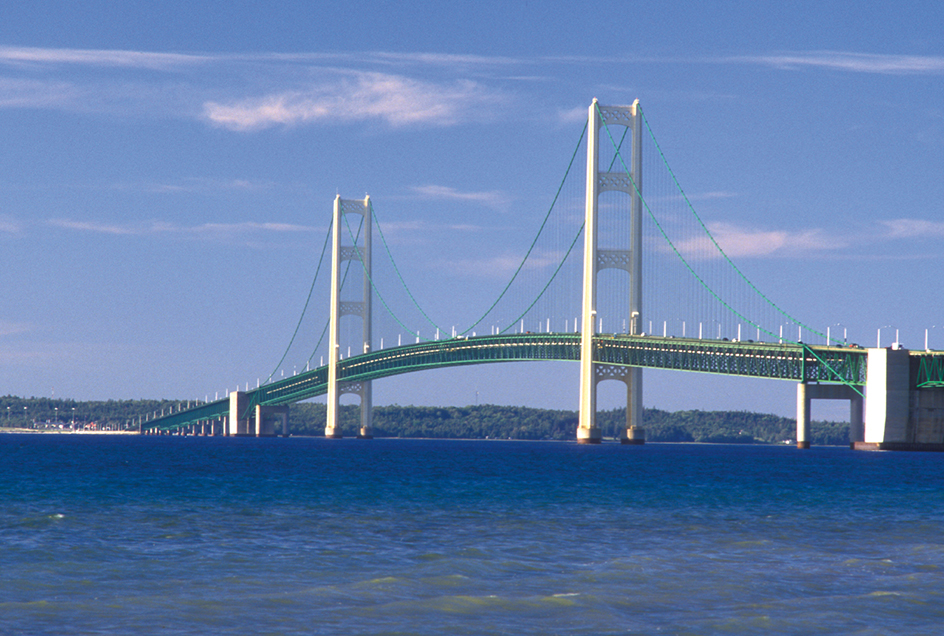
Today, Michigan has an extensive system of roads and highways. Rail lines provide freight service on thousands of miles of track in the state. Detroit Metropolitan Wayne County Airport, Michigan’s chief air terminal, is the state’s busiest airport. Grand Rapids has the state’s second busiest airport.
Ships from Michigan ports carry huge cargoes across the Great Lakes and through the Great Lakes-St. Lawrence Seaway system to various ports and even to other countries. The Soo Canals rank among the busiest ship canals in the Western Hemisphere, even though ice closes the canals from December to April. Rivers and canals in Illinois link the Great Lakes system to the Mississippi River. By using the Mississippi River barge system, barges from Michigan can transport cargo as far south as the Gulf of Mexico.
Detroit is Michigan’s largest and busiest port. Other major ports in the state include Calcite (near Rogers City), Escanaba, Presque Isle, St. Clair, and Stoneport. An automobile ferry service crosses Lake Michigan between Ludington and Manitowoc, Wisconsin. Ferries also serve the Manitou Islands, Beaver Island, Mackinac Island, Isle Royale, and several smaller islands.
Communication.
Michigan’s first regularly published newspaper, the Detroit Gazette, was started in 1817. Today, daily newspapers with the largest circulations include the Detroit Free Press, The Detroit News, and the Grand Rapids Press. Radio station WWJ in Detroit began broadcasting in 1920. WWJ and Pittsburgh’s KDKA were the nation’s first regular commercial radio stations. Michigan’s first TV station, WWJ-TV, began operating in Detroit in 1947.
Government
Constitution.
Michigan’s present Constitution was adopted in 1963 and went into effect in 1964. Earlier constitutions were adopted in 1835, 1850, and 1908.

Constitutional amendments (changes) may be proposed in three ways. Initiative amendments are introduced by petitions signed by a specified number of voters. Legislative amendments are introduced by members of the Legislature. Legislative amendments must be approved by two-thirds of the members of both houses of the Legislature. Amendments can also be proposed by constitutional conventions. Beginning in 1978, and every 16 years thereafter, the voters will decide whether to call a constitutional convention. All proposed amendments must be approved by a majority of the voters who cast ballots on the amendment.
Executive.
The governor serves a term of four years and may serve no more than two terms. The lieutenant governor, secretary of state, and attorney general also serve four-year terms and may serve no more than two terms. The governor and lieutenant governor run for office as a team. Thus, voters in Michigan cast a single vote for the governor and lieutenant governor together.
The governor, with the consent of the Senate, appoints various state officials who are not elected. These officials include the treasurer, members of boards and commissions, and department heads. Officials elected to eight-year terms include regents of the University of Michigan, trustees of Michigan State University, governors of Wayne State University, and members of the State Board of Education.
To run for governor, candidates of major political parties must be nominated by the people in a primary election. Candidates for other statewide elective offices are nominated at party conventions. A recall law gives the people the right to vote to remove from office any elected officials other than judges. A specified number of qualified voters must sign a petition in order to hold such a recall vote.
Legislature
of Michigan consists of a 38-member Senate and a 110-member House of Representatives. State senators serve four-year terms and may serve no more than two terms. State representatives serve two-year terms and may serve no more than three terms. Legislative sessions begin on the second Wednesday of every January. The sessions adjourn on a date determined by a joint resolution of the two houses. The date is usually in December. 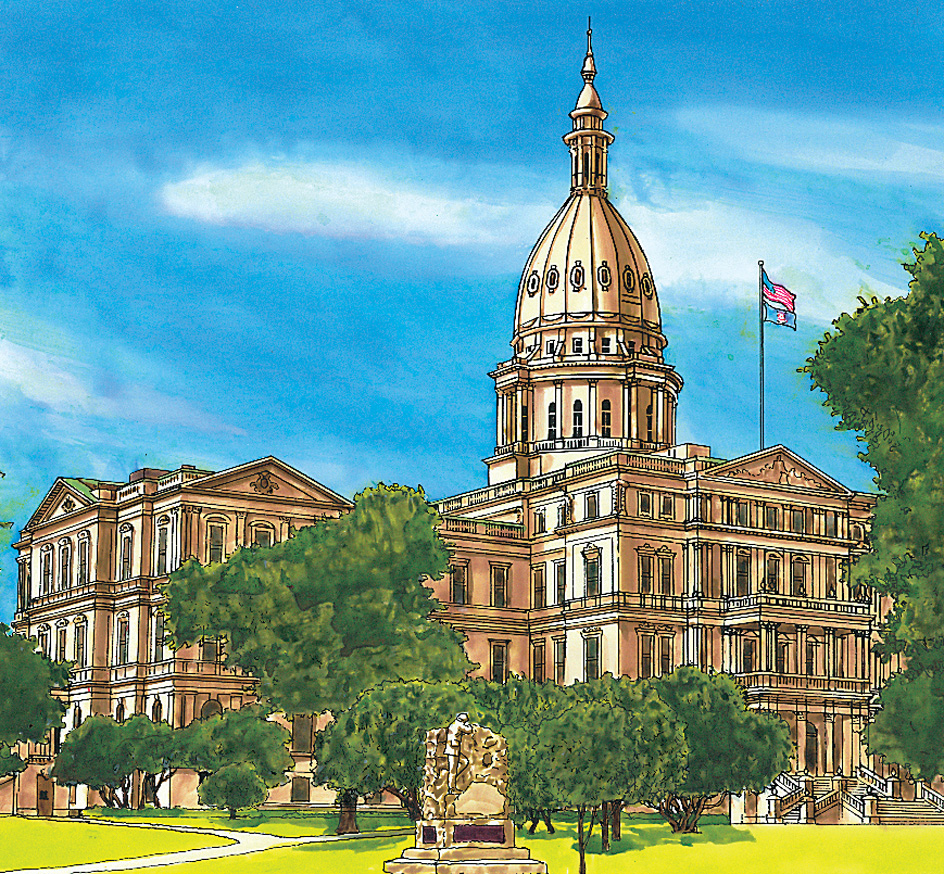
Courts.
Michigan’s highest court is the state Supreme Court. This court has seven justices, elected to eight-year terms. The justices elect one of their members to serve as chief justice.
Michigan also has a Court of Appeals. Judges are selected from each of four districts drawn according to population. Michigan has 57 circuits, each with its own circuit court. Circuit courts are the highest trial courts in the state. District courts and probate courts make up the next level of the judicial system. Four cities in southeastern Michigan have special municipal courts. All appeals, circuit, district, probate, and municipal court judges are elected to six-year terms.
Local government.
The county is Michigan’s chief unit of local government. The state has 83 counties, each of which is divided into townships. Each county has a county board of commissioners as its legislative body. The board consists of representatives from each part of the county. Other officers include the county clerk, county treasurer, prosecuting attorney, register of deeds, and sheriff.
The Constitution permits counties, cities, and villages to have home rule (self-government) to the extent that they may frame, adopt, and amend their own charters. However, these powers can be restricted by the Constitution and the Legislature. Most Michigan cities and villages have a council-manager form of government. The others have a mayor-council form. Counties adopting a home rule charter may have a county executive as their chief administrative officer.
Revenue.
Taxes account for about half of the state government’s general revenue (income). About a third of the general revenue comes from federal grants and programs. Other sources include fees for government services and a state lottery. Important sources of tax revenue include personal and corporate income taxes, a general sales tax, and taxes on motor fuel.
Politics.
The Republicans are strong in many rural and suburban areas. Democratic strength lies in Detroit, Lansing, Ann Arbor, and other urban areas.
Michigan was a solidly Republican state from the 1850’s through the 1920’s. Since then, its voters have supported presidential candidates from both parties. In gubernatorial contests, Michigan has elected more Republicans than Democrats.
History
Early days.
About 15,000 Indigenous Americans lived in the Michigan area when Europeans first arrived. Most of the people belonged to groups who spoke an Algonquian language. They included the Ojibwe (also called Chippewa) and Menominee in the Upper Peninsula, and the Miami, Ottawa (also called Odawa), and Potawatomi in the Lower Peninsula. The Wyandot, who settled around what is now Detroit, belonged to the Iroquoian language group. Only about 3,000 Indigenous Americans lived in the forests of the Upper Peninsula.
French exploration and settlement.
Étienne Brulé of France explored the Upper Peninsula around 1620. He was probably the first European to visit the Michigan region. Brulé was sent to the Michigan region from Quebec by Governor Samuel de Champlain of New France (Canada). See Brulé, Étienne.
In 1634, Champlain sent another explorer, Jean Nicolet, to the region to search for a route to the Pacific Ocean. Nicolet traveled through the Straits of Mackinac (see Nicolet, Jean). In 1660, Father René Ménard, a Jesuit missionary, established a mission at Keweenaw Bay. In 1668, Father Jacques Marquette founded Michigan’s first permanent European settlement, at Sault Ste. Marie (see Marquette, Jacques).
During the late 1600’s, Father Marquette; Louis Jolliet; René-Robert Cavelier, Sieur de La Salle; and other Frenchmen explored much of the region. They mapped many of the lakes and rivers. By 1700, the French had built forts, missions, and trading posts at several places in both the Upper and Lower peninsulas. In 1701, Antoine de Lamothe Cadillac founded Fort Pontchartrain, which grew into the city of Detroit. 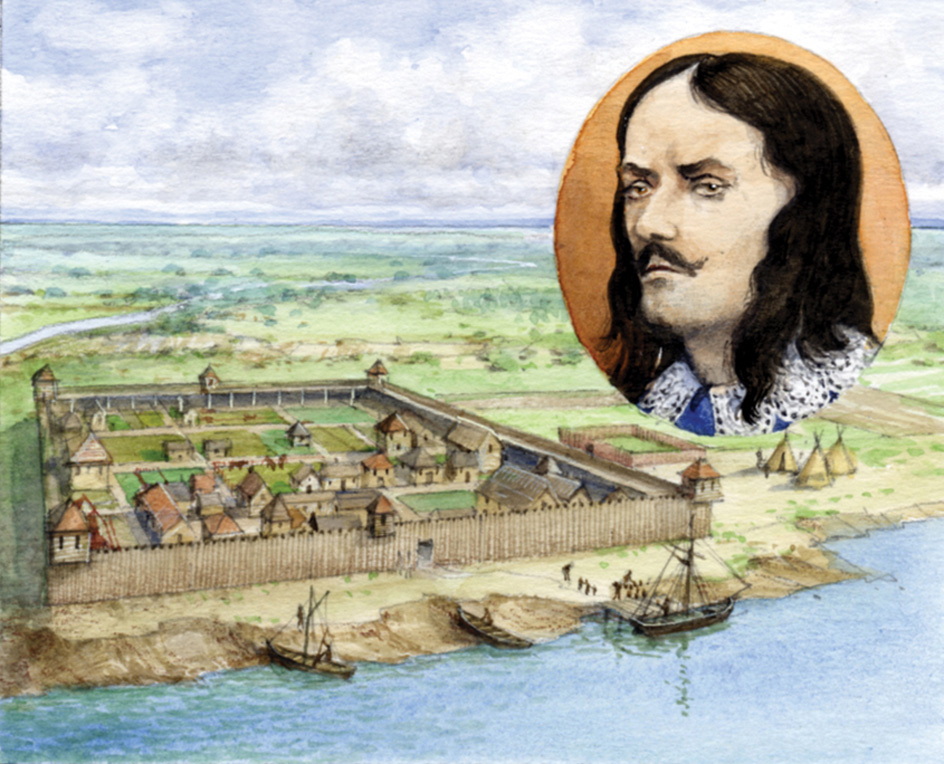
The Michigan region made little progress under the French. Only a few European settlers established farms in the region, mostly along the Detroit River. The main French interests were to convert the Indigenous people to Christianity and to develop a profitable fur trade. They also hoped to use the region as a passage to the west.
British control.
During the late 1600’s and the 1700’s, France and the United Kingdom struggled to gain control of North America. They fought a series of wars, and the French were defeated in 1763. The United Kingdom won most of the French holdings in North America, including the Michigan region. See French and Indian wars.
In 1763, during Pontiac’s War, an alliance of several Indigenous groups led by the Ottawa chief Pontiac attacked the British at Fort Michilimackinac in Mackinaw City. They also attacked a number of other forts, killing many of the settlers. The alliance began a siege against Detroit in May 1763 but it was finally turned away in October. In 1774, the British made Michigan part of the province of Quebec. The British were more interested in fur trading than in settling the region.
During the American Revolution (1775-1783), the British sent raiding parties of Indigenous warriors and white troops from Detroit to attack American settlements in Kentucky. Spain and the United Kingdom also fought each other during the Revolutionary War. In 1781, Spanish forces captured Fort St. Joseph in Niles and held it one day. The Revolutionary War ended in 1783, and the Michigan region eventually came under the control of the United States. The British wanted to hold on to the valuable fur trade as long as possible. They did not surrender Detroit or Fort Mackinac to the United States until 1796.
Territorial period.
In 1787, the Michigan region became part of the Northwest Territory—the first territory established by the United States government (see Northwest Territory). In 1800, Congress created the Indiana Territory, which included part of Michigan. The Indiana Territory obtained the entire Michigan region in 1803. In 1805, Congress established the Territory of Michigan. The territory included the Lower Peninsula and a small section of the easternmost part of the Upper Peninsula.
During the War of 1812, the British captured Detroit and Fort Mackinac. American forces regained Detroit in 1813. The British returned Fort Mackinac to the United States in 1815, after the war ended.
The Erie Canal was completed in upstate New York in 1825. This canal linked the Great Lakes with the Atlantic Ocean and, in doing so, provided a transportation route between the eastern states and the western territories. Many settlers came to Michigan at this time, especially from New York and New England. See Erie Canal.
In 1835, a convention drew up a state constitution. The people ratified (approved) the Constitution on Oct. 5, 1835, and elected 23-year-old Stevens T. Mason as their first state governor. But Congress delayed admitting Michigan to the Union because of a dispute between Michigan and Ohio. The dispute involved a strip of land near Toledo.Congress settled the question in 1836 by giving the 520-square-mile (1,347-square-kilometer) “Toledo Strip” to Ohio and agreeing to let the western Upper Peninsula become part of Michigan.
Progress as a state.
Michigan became the 26th state of the Union on Jan. 26, 1837. In 1842, the state obtained the western Upper Peninsula in a treaty with the Ojibwe. That area soon proved to be a source of many valuable minerals. Copper mining began in the Keweenaw Peninsula in the mid-1840’s. Iron-ore mining began near Negaunee in 1845. Large numbers of miners and prospectors soon came to the Upper Peninsula. By the late 1840’s, mining was prospering in the state. But the miners needed some way to ship the ore from western Michigan to the industrial centers near the Great Lakes. This need was one of the chief reasons for the construction of the Soo Canal, which was completed in 1855 (see Soo Canals). 
The Republican Party was named in 1854 in Jackson. Delegates to a Michigan state convention met there on July 6, 1854. They were the first to formally adopt the name Republican (see Republican Party).
Michigan soldiers fought in the Union Army during the American Civil War (1861-1865). General George A. Custer, a famous Union officer, led the Michigan Cavalry Brigade. On May 10, 1865, the Fourth Michigan Cavalry captured Jefferson Davis, president of the Confederacy, near Irwinville, Georgia.
After the Civil War, lumbering became a leading industry in Michigan. The construction of sawmills aided the rapid development of manufacturing in the state. Michigan lumber was used in building many cities, towns, and farms of the Midwest. Michigan hardwood lumber helped develop the furniture industry, which started in Grand Rapids in the 1830’s. Michigan led the nation in lumber production from 1869 to 1899.
From 1870 to 1900, Michigan’s population more than doubled. Agriculture developed as settlers poured into Michigan and cleared the land. Michigan took the lead among the states in the support of public education. Railroads and steamship lines promoted Michigan resorts, and the state’s tourist industry began to develop.
The early 1900’s
brought further industrial expansion. In 1899, Ransom E. Olds founded the Olds Motor Works in Detroit. By 1901, the factory was mass-producing Oldsmobiles. Henry Ford organized the Ford Motor Company in 1903 (see Ford Motor Company). Detroit soon became the center of the nation’s automobile industry. This new industry increased Michigan’s population and its prosperity.
In 1914, Henry Ford announced that the Ford Motor Company would share its profits with its workers. Ford also established a minimum wage of $5 a day. At that time, most unskilled workers earned only $1 a day, and skilled workers earned $2.50. 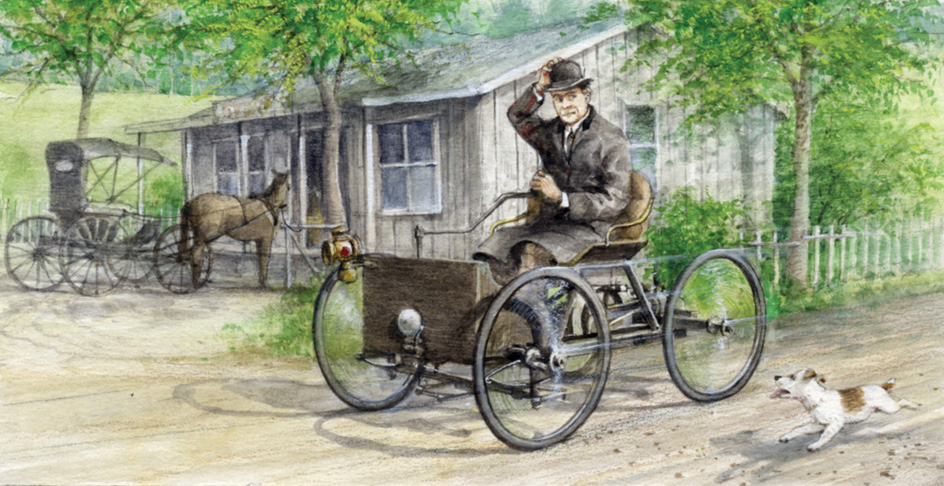
After the United States entered World War I in 1917, Michigan factories built trucks, armored vehicles, steel ships, airplane engines, and other military products. The improvement of Michigan’s highways during the 1920’s contributed to the growth of the automobile industry and related businesses. By the late 1920’s, tourism had become a leading source of income in the state.
Depression and recovery.
Michigan was hit hard by the Great Depression of the 1930’s. Hundreds of thousands of workers lost their jobs. Federal measures to end the Depression had important effects in Michigan. The state had more than 100 Civilian Conservation Corps (CCC) camps. In these camps, the government employed young men to work on conservation projects. The Works Progress Administration (WPA), later renamed the Work Projects Administration, employed about 500,000 people in Michigan to work on public works projects. Before and during the Depression, copper mining in other states became less costly than in Michigan. It cost more to mine copper in Michigan because the ore lies so deep in the earth. Michigan’s copper mining decreased, and more unemployment resulted in the Upper Peninsula.
In 1935, workers in the automobile industry organized the United Automobile Workers (UAW) union. In December 1936, the union went on strike at the General Motors plants in Flint. The strikers demanded a closed shop (an industry in which only union members can be hired). The UAW also called for collective bargaining (discussion of differences between company and union representatives).
The General Motors plant officials rejected the UAW demands. The strikers then locked themselves inside the plants and fought off police attempts to remove them. The UAW received collective bargaining rights on Feb. 11, 1937, and the strike ended. The union won the same rights from the Chrysler Corporation in March 1937. After signing a contract with the Ford Motor Company in 1941, the UAW represented the workers of all the large automobile companies and won its chief demands. These demands included higher pay and recognition of the union as representative of the workers.
The mid-1900’s.
The United States entered World War II in December 1941. From 1942 until the war ended in 1945, Michigan’s entire automobile industry switched to manufacturing war materials. The state produced huge amounts of airplanes, ships, tanks, and other military equipment. The work contributed greatly to the war effort and also brought prosperity back to the state. 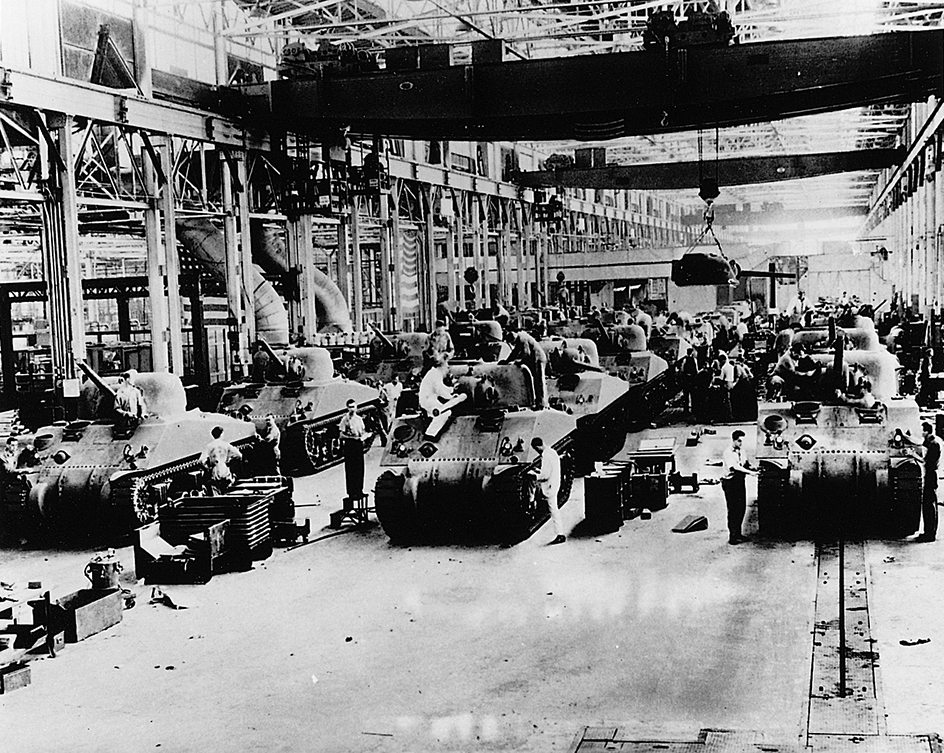
G. Mennen Williams, a Democrat, served as governor of Michigan from 1949 to 1960 (see Williams, G. Mennen). He helped revive two-party politics in Michigan. Michigan’s prosperity continued during his terms in office. Millions of Americans bought new cars and other products that were made in Michigan. The state’s mining industry began to recover. In 1955, a new copper mine opened near Ontonagon. Iron-mining companies in Michigan’s Upper Peninsula developed new methods of recovering iron from nonmagnetic ore and new ways of processing ore for shipment to steel plants. In 1957, the Mackinac Bridge was completed, linking the Upper and Lower peninsulas.
The state faced financial problems during the late 1950’s and early 1960’s. A nationwide recession caused a slump in Michigan automobile sales and production. As a result, other business activities in the state also slowed down. Michigan’s financial picture brightened as the nation began to prosper again during the 1960’s, and purchases of automobiles and other Michigan products increased.
In 1961, Michigan voters authorized a constitutional convention to revise the outdated state constitution, which had been adopted in 1908. They narrowly approved the new constitution in 1963, and it went into effect in 1964.
George W. Romney, a Michigan businessman, served as the state’s governor from 1963 to 1969. Romney, a Republican, had played a leading role in the constitutional convention. As governor, he fought for passage of the new constitution. Romney’s administration modernized the state tax structure. New taxes, including a state income tax adopted in 1967, enabled Michigan to increase spending for education, mental health facilities, welfare programs, and other government services. In 1972, Michigan established a state lottery to help raise additional money. See Romney, George Wilcken.
In July 1967, an eight-day riot broke out in a predominantly African American section of Detroit. Rioters burned buildings and looted stores. Forty-three people were killed, and about $45 million worth of property was damaged or destroyed.
In 1973, President Richard M. Nixon appointed Congressman Gerald R. Ford of Michigan to succeed Vice President Spiro T. Agnew, who had resigned. Ford became the 38th president in 1974, when Nixon resigned because of his involvement in the Watergate scandal.
The late 1900’s.
Nationwide recessions during the early 1970’s and the early 1980’s contributed to slumps in the automobile industry, and unemployment in Michigan rose sharply. By 1980, Michigan had the highest unemployment rate of any state. A serious financial crisis in the early 1980’s forced the state government to cut funding for education, mental health services, welfare programs, and other services. By late 1983, however, improved automobile sales reduced the state’s unemployment, and a temporary increase in the income tax enabled the state to restore program cuts.
In the 1990’s, the production of transportation equipment remained the most important manufacturing activity in the state. Michigan leaders worked to attract new industries to reduce the state’s dependence on the automobile industry.
The early 2000’s.
The economy weakened and unemployment rose throughout the nation in the early 2000’s. Michigan was especially affected by the loss of manufacturing jobs. A number of companies moved to other countries because labor costs were lower there.
In 2002, Michigan voters elected Jennifer Granholm governor. Granholm, who held the office from 2003 to 2011, was the first woman to serve as governor of the state.
In 2009, Michigan suffered more than most states from the effects of a national economic downturn. The state’s automobile industry was in crisis, and both Chrysler and General Motors required bailouts from the federal government. The state’s unemployment rate reached 15 percent, the highest such rate in the state since 1982. The state’s economy largely recovered during the 2010’s, and unemployment fell to about 5 percent.
In 2020, Michigan faced severe economic and social disruptions as COVID-19 spread throughout the world. The sometimes-fatal respiratory disease, caused by a type of coronavirus, emerged from China in late 2019. Michigan’s first confirmed cases occurred in the Detroit metropolitan area in early March 2020. Authorities soon urged residents to practice social distancing. Later in March, Governor Gretchen Whitmer issued a statewide stay-at-home order, and many businesses considered nonessential were ordered to close. High numbers of cases overwhelmed hospitals in Detroit.
In April 2020, conservative protesters—angered by the business closures and skeptical of the public health warnings—held rallies in Lansing. Authorities began to relax business restrictions in some areas later that month. During the months that followed, officials raised or lowered restrictions based on the severity of local infection rates. Vaccines to help prevent infection with COVID-19 became available to most Michigan residents by the spring of 2021. Higher vaccination rates generally led to lower death rates, but outbreaks continued to occur. By early 2023, about 3 million COVID-19 infections had been recorded in Michigan, and more than 40,000 people there had died from the disease.
